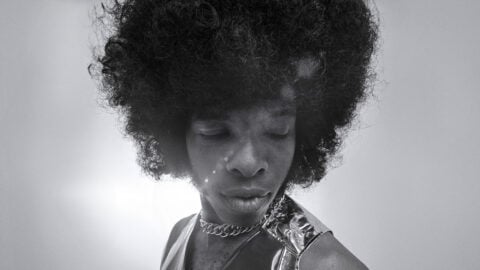Foundas on Film: Sucker Punch, Miral

The studio logos at the start of Zack Snyder’s Sucker Punch appear emblazoned on a velvet stage curtain, and the movie that follows is an unbridled loop-de-loop ride within the proscenium of Snyder’s imagination. Round and round we go, from a gothic nut house to an opulent whorehouse, and from the trenches of World War I to a medieval kingdom where fire-breathing dragons rule the land. And did I mention it’s also a musical? Balls to the wall and pedal to the metal, this post-postmodern, 3D-without-the-glasses, pastiche to end all pastiches will leave you feeling some combination of disoriented, exhausted, and irrepressibly giddy. To call Sucker Punch batshit crazy might well be the understatement of the year.
Before we go any further, I must admit that I have come late to the cinema of Zack Snyder. In 2004, on assignment for Variety, I reviewed his debut feature, the remake of George A. Romero’s Dawn of the Dead, which struck me then (and still does) as a serviceable fright fest entirely lacking in the humor, sly social commentary and (above all) human dimension of the original. So I felt no great need to see Snyder’s subsequent graphic novel adaptations, 300 and Watchmen, during my tenure at the L.A. Weekly, where I entrusted those reviews to others, sure that the films were further evidence of the same competent but uninspired, fanboy-pandering hack work.
As I discovered only recently, in both cases I was wrong, particularly with respect to Watchmen, which exists alongside There Will Be Blood, The Social Network, and Inception at the very outer limit of what is conceivable, in terms of narrative ambition, in a major studio movie in today’s Hollywood. It is, I think, a major film about America—one that, in its elaborate post-Cold War counter-history, dares to suggest that what we regard as the failure of the American Dream may in fact be a queasy ideological victory. It is also ravishing cinema, surprisingly classical in its shooting and cutting, with a sumptuous eye for detail, and a strategy for navigating its overlapping time periods that is as nimble as Sergio Leone’s in the long version of Once Upon a Time in America (a fine alternate title for Snyder’s film). In the not too distant future, I suspect, filmgoers will look back on the middling reviews and underwhelming box office that greeted Watchmen in much the way we now marvel at the similarly low impact made by Blade Runner during its initial run.
By comparison, Sucker Punch—the first film Snyder has made from his own original story—seems a rambunctious divertissement, a movie of no greater goal than to celebrate the low, lurid pleasures of losing ourselves in a darkened theater. It’s close to what Quentin Tarantino and Robert Rodriguez were after with their Grind House double-header, but shot through with Snyder’s own psychotropic brio (which is something like the unholy union of David Lynch, Brian De Palma and Ken Russell). The movie’s principal heroine, called Babydoll and very well played by the blond, pig-tailed Australian cherub Emily Browning, is a victim of circumstance, committed by her wicked stepfather to an asylum for the criminally insane following the shooting death of her sister. Although the sinister institution is called Mt. Pleasant and allegedly located somewhere in Vermont, its true location is our memory of madhouse melodramas like The Snake Pit, Shock Corridor,and Shutter Island, in which it is ever more difficult to distinguish the inmates from their minders. One of the staff, a certain Dr. Gorski (Carla Gugino), submits her patients to an experimental “Polish therapy” in which they are asked to re-enact their various traumas in the form of drama, on a stage, in a large communal room known as “the theater.” The period is nominally the Sixties, but by the time “Sweet Dreams (Are Made of These)” erupts on the soundtrack, all such bets are off.
Indeed, in Sucker Punch, all the world’s a stage upon which the film’s men and (primarily) women are mere players. Most of the movie takes place in a single suspended moment, as Babydoll, about to be lobotomized the old fashioned way (with hammer and pick) suddenly goes over the rainbow, or down the rabbit hole, and finds herself no longer in dreary Mt. Pleasant but rather as a captive of a crimson-hued house of ill repute, where the oddly familiar “Madame” Gorski coaches Babydoll and four other showgirls (named Sweet Pea, Rocket, Blondie, and Amber) to dance for high-end clients.
And there are yet more fantasies to come. In the major and minor Hollywood musicals of yesteryear (Snyder favors the latter, decorating the dancers’ dressing room with posters from the 1949 Doris Day vehicle My Dream Is Yours and the 1938 Busby Berkeley review Gold Diggers in Paris), the songs and dances also functioned as a kind of subconscious escapism, a way for the characters to do and say things they couldn’t do or say in ordinary reality. In Sucker Punch, when Babydoll dances—a hypnotic routine that entrances all who behold it (but which Snyder never shows us)—she too escapes into her subconscious, envisioning herself as a fearsome warrior battling giant samurai, German zombies, and other fantastic beasties, her sisters-in-arms by her side, fighting for their freedom. Each time through, that redoubtable hardass, Scott Glenn, appears as a kind of master of ceremonies, egging the girls on with such zen words of wisdom as “If you don’t stand for something, you’ll fall for anything.” Natalie Portman’s unhinged prima ballerina in Black Swan had nothing on this.
In case you haven’t gathered, Sucker Punch isn’t for everybody. Those offended by the idea of a world where all women are virtuous whores and all men leering, lecherous pigs are advised to keep their distance, as is anyone expecting a poetic contemplation of identity, authorship and the hazy line between life and art (which is not to say that such things aren’t on Snyder’s mind). More than aptly titled, Sucker Punch is anything but subtle, and Snyder doesn’t pretend otherwise. He simply hurls every idea he’s ever had for a movie at the screen all at once, as if he might never get to do it again, and some of them stick and some of them don’t, and none of it really matters. And I can’t wait to see it again.

This week’s other portrait of female solidarity in the war zone, Julian Schnabel’s Miral takes its title—we’re told in onscreen text at the start, and later, for non-readers, in dialogue—from the name of an inconspicuous red flower that grows by the side of the road. Schnabel’s film, meanwhile, is the sort of thing that grows in the heads of well-intentioned liberal filmmakers who want to open our eyes to some egregious violation of human rights in some misbegotten corner of the world, or right here in our own backyard. Trumped up by Harvey Weinstein into a headline-grabbing cause célèbre—complete with a star-studded (and protester-picketed) UN premiere—Miral, which follows the lives of four Palestinian women from the formation of Israel in 1947 until the present day, has been widely accused of proffering a one-sided, pro-Arab agenda (and a cameo by Zionist bête noire Vanessa Redgrave). But if Schnabel’s film takes a side, it isn’t that of Israel or Palestine, but rather the side of movies like the recent The Visitor and The Lives of Others that succeed in reducing complex sociopolitical conflicts to bathetic lessons in peace and understanding.
Schnabel, for his part, insists that Miral isn’t a political film at all, but rather a movie about love—and doubtless, for him, it is. It was adapted from an autobiographical novel by Italian-Palestinian author and journalist Rula Jebreal, who also wrote the screenplay and who currently lives together with the Jewish Schnabel in his West Village converted warehouse—a one-state solution if ever there was. “We love to do things together,” Jebreal commented in a recent Vanity Fair story, before proceeding, without a lick of irony, to quote Pope John Paul II’s musings on modern marriage. Now Miral arrives as Schnabel and Jebreal’s wedding gift to the world, and if the end result is pure hokum, it’s hokum made with incredible dewy-eyed sincerity.
A multi-generational roundelay of Palestinian misery and woe, Miral begins as a biographical portrait of Hind Husseini, the heir of a prominent Arab family who, in 1945, transformed her large Jerusalem estate into an orphanage and school for displaced Palestinian children. That Husseini is played with reserves of quiet dignity by the great Palestinian actress Hiam Abbas helps to obscure, but not negate the fact that she is trapped in the role of a one-dimensional secular saint—an Arab Mother Theresa—in a movie chock-a-block with angelic orphans, romantic revolutionaries, and evil, warmongering Israeli soldiers.
From there it’s on to Nadia (Yasmine Al Massri), who runs away from an abusive father and ends up in jail for assaulting a Jewish woman on a bus. Behind bars, she meets Fatima (Ruba Blal), a former nurse serving time for her role in a movie theater bombing. She also catches the eye of Fatima’s kind brother, Jamal (Alexander Siddig), who upon Nadia’s release takes her as his bride. Together they raise a daughter, Miral (Slumdog Millionaire’s Freida Pinto), who becomes a student in Husseini’s school and, as an impressionable teen during the First Intifada, falls for Hani (Omar Metwally), an impassioned radical ready for his close-up on a commemorative T-shirt.
Unlike the schoolgirl suicide bomber of Bruno Dumont’s superb recent Hadewijch, Miral never seriously flirts with radicalism, regardless of the Weinstein Company posters for the film, which feature a full-size photo of Pinto framed by the tagline “Is this the face of a terrorist?” She and Hani make goo-goo eyes for a while, as she reads a book about natural disasters and he likens the Israeli Occupation to a cancer—all of it so beautifully filmed by the French cameraman Eric Gautier that you wish you could turn off the pedantic dialogue. Eventually, Miral learns that not all Israelis are bad when she befriends her cousin’s extroverted Jewish girlfriend (played by Schnabel’s daughter, Stella), though Miral’s aunt proves considerably less welcoming in one rather funny scene that plays like an Arab-Israeli spin on Guess Who’s Coming to Dinner. It may be the only moment in the film not crippled by ideological portent.
Schnabel dedicates Miral to “everyone on both sides who still believes peace is possible”—a noble sentiment, to be sure, but will anyone on either side really see themselves reflected in such a simplistic, ham-fisted treatment? Late in the film, as Rabin and Arafat negotiate the Oslo accords, a reporter advises the aspiring newswoman Miral, “If you want to be a journalist, you need to get your hands dirty.” It’s advice Schnabel, too, would have been well advised to follow.







